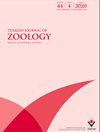利用脂肪酸组成和耳石形状分析对突尼斯湾六种具有商业价值和生态多样性的鱼类进行区分
IF 1.7
4区 生物学
Q2 ZOOLOGY
引用次数: 0
摘要
对突尼斯突尼斯湾6种重要商业鱼类的脂肪酸组成和耳石形状变化进行了分析,这些鱼类在生态上的生活和摄食习性不同。目的是利用脂肪酸组成和耳石形状来研究6种物种之间的区别和关系,以检验脂肪酸组成的变化是否与耳石形状的变化一致,并检查耳石形状和脂肪酸组成是否结合了这些物种的特征信号。Tukey的单因素方差分析表明,6种鱼的饱和脂肪酸(sfa)、多不饱和脂肪酸(PUFAs)和单不饱和脂肪酸(MUFAs)的总百分比在个体之间存在显著差异,并且仅在黑Gobius和Trachinus draco的雄性和雌性之间存在显著差异。判别函数分析(Discriminant function analysis, DFA)将6种植物划分为两个不同的主要聚类或类群。第一组包括马刺,G。和T。第二种包括沙丁鱼、地中海沙鱼和auratus,它们是底栖到远洋的物种。Wilk’s λ检验和Fisher’s distance (D)矩阵显示,6种个体的左右耳石形状存在显著的双边不对称,且仅存在于C的雌雄之间。奥拉图,T。地中海和G。尼日尔。然而,显著的双侧不对称仅在G。黑曲霉和雄性黑曲霉。德拉科。DFA和基于耳石形状方差的分层上升分类(HAC)显示,两组耳石与脂肪酸组成分析结果一致。结果表明,脂肪酸组成分析与耳石形状分析是兼容的,两者都结合了这些物种的特征信号,并验证了脂肪酸组成和耳石形状分析是区分这些物种和物种内部的有效方法。本文章由计算机程序翻译,如有差异,请以英文原文为准。
Discrimination between six commercially relevant and ecologically diverse fish species across the Gulf of Tunis using fatty acid composition and otolith shape analyses
: Fatty acid composition and otolith shape variation of six commercially important fishes, which differ ecologically in their living and feeding habits across the Gulf of Tunis, Tunisia, were analyzed. The aims were to investigate the discrimination and relationship between the six species using both fatty acid composition and otolith shape to examine whether variability in fatty acid composition is consistent with variation in otolith shape and check whether otoliths shape and fatty acids composition have combined characteristic signals for these species. Tukey’s test with one-way ANOVA indicated significant differences in total percentages of saturated (SFAs), polyunsaturated (PUFAs), and monounsaturated (MUFAs) fatty acids between individuals of the six species, and only between males and females of Gobius niger , and Trachinus draco . Discriminant function analysis (DFA) separated the six species into two main distinct clusters or groups. The first group comprised Mullus barbatus , G . niger , and T . draco , which assume a benthic life, while the second included Sardina pilchardus , Trachurus mediterraneus, and Chelon auratus , which are benthopelagic to pelagic species. Wilk’s λ test and Fisher’s distance ( D ) matrix showed a significant bilateral asymmetry in the left and right otoliths shape between individuals of the six species, as well as only between males and females of C . auratus , T . mediterraneus , and G . niger . However, a significant bilateral asymmetry was found only between females of G . niger and males of T . draco . DFA and hierarchical ascending classification (HAC) based on otolith shape variance revealed two main groups of otoliths congruent to those obtained from fatty acid composition analysis. The results indicated that fatty acid composition analysis was compatible with otolith shape analysis, and both have combined characteristic signals for these species and validated the use of fatty acid composition and otolith shape analyses as an effective approach to discriminate between and within these species.
求助全文
通过发布文献求助,成功后即可免费获取论文全文。
去求助
来源期刊

Turkish Journal of Zoology
ZOOLOGY-
CiteScore
2.30
自引率
10.00%
发文量
24
审稿时长
6-12 weeks
期刊介绍:
The Turkish Journal of Zoology is published electronically 6 times a year by the Scientific and Technological Research Council of Turkey (TÜBİTAK).
-Accepts English-language manuscripts in various fields of zoology including systematics, developmental biology, behaviour biology, animal models, molecular biology and molecular phylogeny, genomics, physiology (cell communication and signaling systems), biochemistry and immunohistochemistry, applied parasitology and pathology, nanobiotechnology, ecology, evolution, and paleontology of animal taxa.
-Contribution is open to researchers of all nationalities.
-Short communications are also welcome, such as reports of a preliminary nature or those including new records from specific localities or regions, and the editor reserves the right to decide that a paper be treated as a short communication.
-The papers that deal with purely checklists, new host and non-regional new locality records will not be consider for publication.
-Letters to the editor reflect the opinions of other researchers on the articles published in the journal. The editor may also invite review articles concerning recent developments in particular areas of interest.
 求助内容:
求助内容: 应助结果提醒方式:
应助结果提醒方式:


